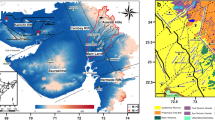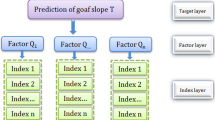Abstract
It is a significant task to evaluate the seafloor stability for the exploitation of marine resources and the construction of marine structures. This paper analyzes the impact factors of submarine slope instability using geological and geophysical data of the Baiyun Sag in the Pearl River Mouth Basin and builds the evaluation index system of submarine slope instability. The weight of each index is calculated by analytic hierarchy process method to weaken subjective effect. Gray clustering method is applied to estimate the risk of submarine slope instability in Baiyun Sag qualitatively and quantitatively. The assessment standard is divided into five grades, and the whitening function of each gray cluster is determined by the assessment scheme. The gray evaluation weight vector of each indicator is calculated by the table-dispatching method. The gray assessment value is estimated by making the gray assessment weight vector single value, and the gray grade is determined according to the maximum principle. The evaluation results show quantitatively that the risk grade of submarine slope instability in the Baiyun Sag is medium, and the gray clustering method is reasonable and feasible.


Similar content being viewed by others
References
Bindu M, Chandulal AJ (2010) Evaluating web sites using COPRAS-GRA combined with grey clustering. Int J Eng Sci Technol 2(10):5280–5294
Brown HE, Holbrook WS, Hornbach MJ, Nealon J (2006) Slide structure and role of gas hydrate at the northern boundary of the Storegga Slide, offshore Norway. Mar Geol 229:179–186
Ding Y (1994) The active faults and the seismic activity in the Pearl River Mouth Basin and its vicinity areas. Earthq Res China 10:307–319 (in Chinese with English abstract)
Jiang QW, XU Q, He ZW (2005) Study on landslide hazard zonation based on multi-classification support vector machine. J Geol Hazards Environ Preserv 16(3):328–330 (in Chinese with English abstract)
Kayen RE, Lee HJ (1991) Pleistocene slope instability of gas hydrate-laden sediment on the beaufort sea margin. Mar Geotechnol 10(1–2):125–141
Leynaud D, Mienert J, Nadim F (2004) Slope stability assessment of the Helland Hansen area offshore the mid-Norwegian margin. Mar Geol 213:457–480
Leynaud D, Sultan N, Mienert J (2007) The role of sedimentation rate and permeability in the slope stability of the formerly glaciated Norwegian continental margin: the Storegga slide model. Landslides 4(4):297–309
Liu F, Wu SG, Sun YB (2010) A quantitative analysis for submarine slope instability of the northern South China Sea due to gas hydrate dissociation. Chin J Geophys 53(4):946–953 (in Chinese with English abstract)
Locat J, Lee HJ (2002) Submarine landslides: advances and challenges. Can Geotech J 39:193–212
Lu XC, Gong M, Tang LS, Liao HR, Zhang QH (2006) Improved grey association analysis method based on T-S fuzzy neural network model—application in evaluating of landslide hazards in Guangdong Province. Chin J Geol Hazard Control 17(3):143–146 (in Chinese with English abstract)
Marsset T, Marsset B, Thomas Y, Cattaneo A, Thereau E, Trincardi F, Cochonat P (2004) Analysis of Holocene sedimentary features on the Adriatic shelf from 3D very high resolution seismic data (triad survey). Mar Geol 213:73–89
Mcadoo BG, Pratson LF, Orange DL (2000) Submarine landslides geomorphology, US continental slope. Mar Geol 69:103–136
Mienert J (2004) COSTA-continental slope stability: major aims and topics. Mar Geol 213(1–4):1–7
Mienert J, Vanneste M, Bunz S, Andreassen K, Haflidason H, Sejrup HP (2005) Ocean warming and gas hydrate stability on the mid-norwegian margin at the Storegga slide. Mar Pet Geol 22(1–2):233–244
Nittrouer CA (1999) STRATAFORM: overview of its design and synthesis of its results. Mar Geol 154(1–4):3–12
Nixon MF, Grozic JLH (2007) Submarine slope failure due to gas hydrate dissociation: a preliminary quantification. Can Geotech J 44:314–325
Qin F, Wang ZZ (2012) Discussion and Improvement for slope stability analysis method based on strength reduction FEM. J Water Resourc Archit Eng 10(1):43–47 (in Chinese with English abstract)
Rautela P, Lakhera RC (2000) Landslide risk analysis between Girl and Tons Rivers in Himachal Himalaya (India). Int J Appl Earth Obs Geoinf 2(3–4):153–160
Saaty TL (1980) The analytical hierarchy process. McGraw-Hill, New York
Sultan N, Cochonat P, Foucher JP, Mienert J (2004a) Effect of gas hydrates melting on seafloor slope instability. Mar Geol 213(1–4):379–401
Sultan N, Cochonat P, Canals M, Cattaneo A, Dennielou B, Haflidason H, Laberg JS, Long D, Mienert J, Trincardi F, Urgeles R, Vorren TO, Wilson C (2004b) Triggering mechanisms of slope instability processes and sediment failures on continental margins: a geotechnical approach. Mar Geol 213(1–4):291–321
Sun YB, Wu SG, Wang ZJ, Li QP, Wang XJ, Dong DD, Liu F (2008) The geometry and deformation characteristics of Baiyun submarine landslide. Mar Geol Quat Geol 28(6):69–77 (in Chinese with English abstract)
Tomesgen B, Mohammed MU, Komc T (2001) Natural hazard assessment using GIS and remote sensing methods, with particular reference to the landslides in the Wondogenet area, Ethiopia. Phys Chem Earth (C) 26(9):665–675
Wan SS, Nian TK, Jiang JC, Luan MT (2010) Discussion on several issues in slope stability analysis based on shear strength reduction finite element methods. Rock Soil Mech 31(7):2283–2288 (in Chinese with English abstract)
Wang ZJ (2011) Study of correlationship between mass transport deposits and the dissociation of gas hydrate in Baiyun deepwater area. Oil Geophys Prospect 46(Supplement 1):144–150 (in Chinese with English abstract)
Wang L, Wu SG, Li QP, Wang DW, Fu SY (2014) Architecture and development of a multi-stage Baiyun submarine slide complex in the Pearl River Canyon, northern South China Sea. Geo-Mar Lett. doi:10.1007/s00367-014-0372-4
Wu YP, Tang HM, Ge XR (2005) Application of BP model to landslide hazard risk predication. Rock Soil Mech 26(9):1409–1413 (in Chinese with English abstract)
Wu SG, Chen SS, Wang ZJ, Li QP (2008) Submarine landslide and risk evaluation on its instability in the deepwater continental margin. Geosciences 22(3):430–437
Wu SG, Qin ZL, Wang DW, Peng XC, Wang ZJ, Yao GS (2011) Seismic characteristics and triggering mechanism analysis of mass transport deposits in the northern continental slope of the South China Sea. Chin J Geophys 54(12):3184–3195 (in Chinese with English abstract)
Xie H, Zhou D, Pang X, Li Y, Wu X, Qiu N, Li P, Chen G (2013) Cenozoic sedimentary evolution of deepwater sags in the Pearl River Mouth Basin, northern South China Sea. Mar Geophys Res 34(3–4):159–173
Xu Q, Wang YM, Wang D, Li D (2010) Sedimentary responses of retreating shelf break from Oligocene to Miocene, in deep water Area of Baiyun depression South China Sea. Acta Sedimentol Sin 28(5):906–916 (in Chinese with English abstract)
Zhou D, Sun Z, Liao J, Zhao Z, He M, Wu X, Pang X (2009) Filling history and post-breakup acceleration of sedimentation in Baiyun sag, deepwater northern South China Sea. J Earth Sci 20(1):160–171
Zhu YP, Mo HH (2004) Application of grey correlation analysis to rock slope stability estimation. Chin J Rock Mech Eng 23(6):915–919 (in Chinese with English abstract)
Acknowledgments
The research works are supported by the National Natural Science Foundation of China (Nos. 41206042, 51309239), National Science and Technology Major Project (No. 2011ZX05026-004-06), the Open Foundation of Key Laboratory of Marine Geology and Environment of Chinese Academy of Science (Nos. MGE2012KG01, MGE2011KG12), and the Natural Science Foundation of Shandong Province (No. ZR2011EEQ022).
Author information
Authors and Affiliations
Corresponding author
Rights and permissions
About this article
Cite this article
Li, C., Wu, S., Zhu, Z. et al. The assessment of submarine slope instability in Baiyun Sag using gray clustering method. Nat Hazards 74, 1179–1190 (2014). https://doi.org/10.1007/s11069-014-1241-1
Received:
Accepted:
Published:
Issue Date:
DOI: https://doi.org/10.1007/s11069-014-1241-1




